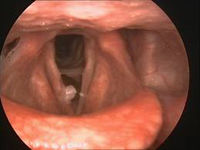Polyps on the vocal cords


Nodes on the vocal cords

Fibroendoscopy
Vocal cord surgery
SCREENING AND DIAGNOSTIC TECHNIQUES
- Video-fibrolaryngoscopy: This allows us to see all the structures of the nose, throat and larynx, including the vocal cords, on a screen via fibreoptics. It is a quick and painless technique and we perform it at our own surgery. No preparation is usually required. In patients who tend to experience nausea, a local anaesthetic is administered for preventative purposes. Both the ENT (ear, nose and throat) specialist and the patient and anyone accompanying them will be able to follow the entire procedure on screen, making the detection and explanation of vocal cord diseases (nodes, polyps, tumours, etc.) easier to understand.
- Stroboscopy: This screening technique enables us to slow down the vocal cords, which allows us to perform a detailed examination of them. Under normal conditions, the vocal cords vibrate at a very high speed, making such examination difficult. This is highly useful for people who use their voices for their job (singers, actors, teachers, salespersons, TV presenters); any child or adult with constant or intermittent changes to their voice; anyone who uses their voice in an activity outside of their profession (singing, theatre, etc.); and in the early diagnosis of laryngeal cancer.
Treatment: Phonosurgery
Phonosurgery is surgery to improve the voice. It involves the surgical treatment of vocal cord abnormalities that cannot be corrected with conventional techniques, medication or speech therapy.
The operation is performed with the use of a microscope and, in many cases, a CO2 laser, which allows for utmost precision while minimising bleeding, preventing postoperative pain and accelerating and improving the healing process.
Stroboscopy
 by Develona
by Develona